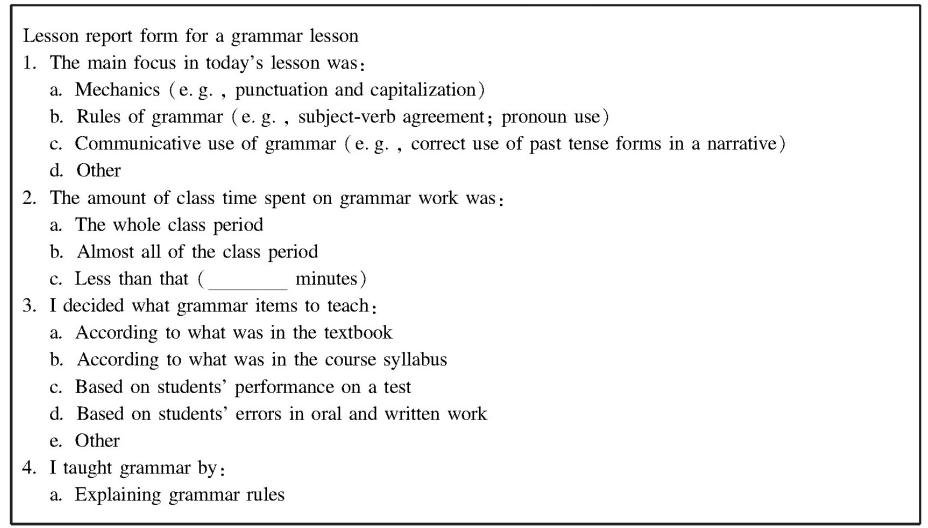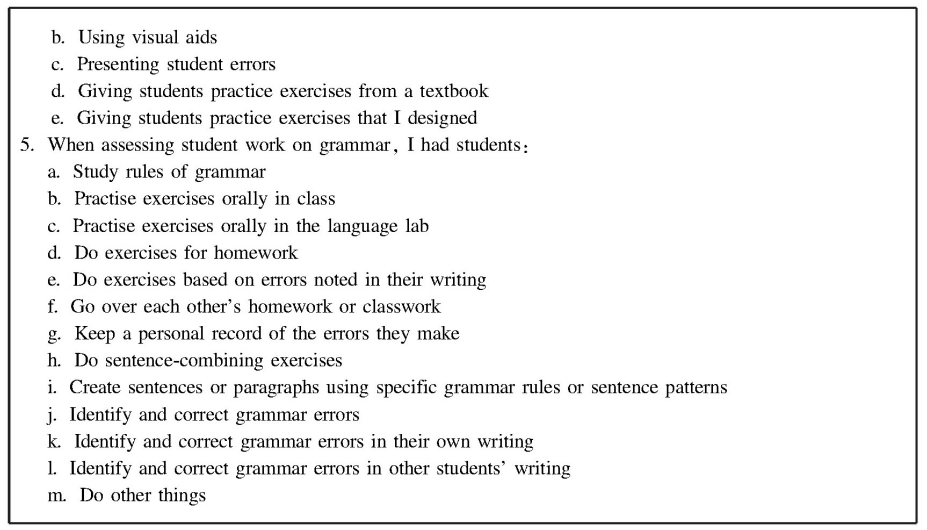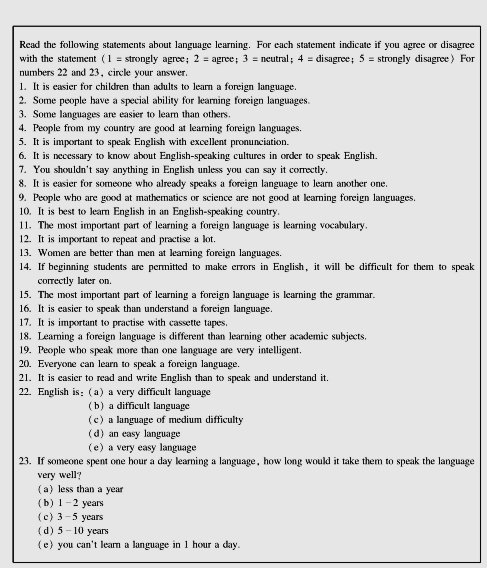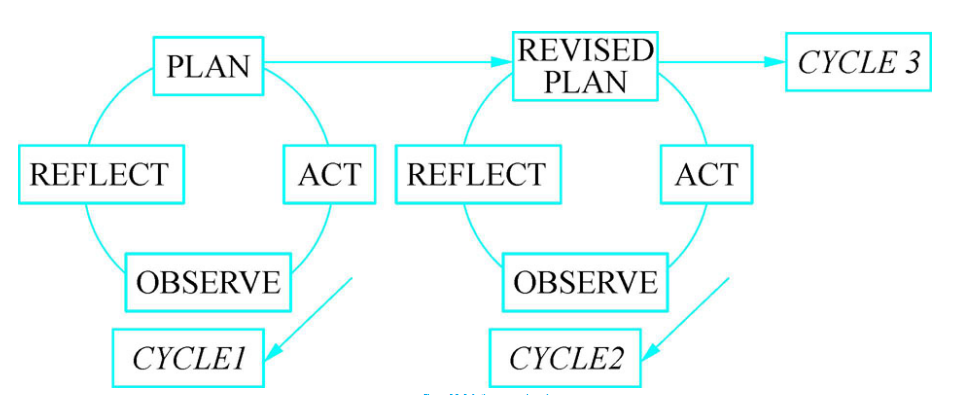Section 2 Reflective Evaluation on Teaching English
 I.Thinking
I.Thinking
【Case Reflection】
Ms J has taught for more than ten years. After each class,she jots down how she feels about the class,her confusions,the good points and excitement she has about the process. What is her purpose in doing this? What benefit can she get from it? Is it difficult to do?
 II.Concept of Reflective Teaching
II.Concept of Reflective Teaching
Reflection is of vital importance for self-development. It refers to an individual's thought about past experiences and learning from those experiences. Reflection is similar to introspection,which is the self-observation and awareness of inner thoughts,desires and sensations. It is a conscious,purpose-driven mental process which relies on thinking,reasoning,and examining one's own thoughts and feelings. The followers of Confucianism advocate introspection to promote self-development. The philosopher Tsang said,“I daily examine myself on three points”(The Analects).
In Western philosophy,the idea of retrospection dates back to Aristotle and Plato. For Locke,reflection is an action the mind performs. When a mind reflects,it takes notice of its own mental operations,and it gains understanding of these operations. Reflection and sensation are two actions of the same faculty. Reflection helps us understand the way the mind treats the objects of sensation,such as knowing,doubting,believing and so forth. Spinoza put forward “reflective knowledge”,which is the “perception of perception” that can promote self-development(Wang,2006).
Reflective teaching is “an approach to teaching and to teacher education which is based on the assumption that teachers can improve their understanding of teaching and the quality of their own teaching by reflecting critically on their teaching experiences”(Richards & Lockhart,2000:391).
Bailey et al.(2004)illustrated the study of reflective teaching of Stanley,Zeichner and Liston. Stanley(1998 cited in Bailey et al. 2004))contends that “... developing a reflective teaching practice can be represented as a series of phases: engaging with reflection,thinking reflectively,using reflection,sustaining reflection,and practicing reflection”. Zeichner & Liston(1996 cited in Bailey et al.,2004)described five dimensions of reflection: rapid reflection,repair,review,research,re-theorizing and reformulating. Rapid reflection is immediate and automatic reflection-in-action(which is reflection that occurs during the teaching process). Repair is thoughtful reflection-in-action. Review is reflection-on-action(which is reflection that occurs before or after teaching)that is less formal and occurs at a particular point in time.
Research is reflection-on-action that is more systemic and occurs over a period of time. Re-theorizing and reformulating are long-term reflection-on-action informed by public academic theories.
 III.Importance of Reflective Teaching
III.Importance of Reflective Teaching
Confucius said,“Learning without thought is labor lost;thought without learning is perilous.” This principle is also true for teaching. A teacher who merely teaches without reflection can only become a student teacher,while a teacher who merely studies without teaching is only a talker. Professor Yelan once said that a teacher cannot become an expert in teaching even if he/she writes teaching plans for his/her whole life,but he/she may become an expert if he/she writes reflection of his/her teaching for three years. Posner pointed out,“Experiences without reflection are only shallow experiences and knowledge. If a teacher is satisfied with merely accumulating experiences without reflective thinking,then he cannot improve his teaching,which may become even worse than before.” He put forward a formula for teachers' development: Growth = experiences + reflection. All these comments illustrate the importance of reflection. It is an important stage of the teaching process,and is the motivation for us to further our learning and development. Richards & Lockhart(2000:2)stated that “reflective teaching can help achieve a better understanding of one's assumptions about teaching as well as one's own teaching practices;it can lead to a richer conceptualization of teaching and a better understanding of teaching and learning processes;and it can serve as a basis for self-evaluation and is therefore an important component of professional development.”
From reflective teaching,we can examine our teaching experiences;we are better informed of the various aspects of our teaching;we can improve our teaching skills;and we can become more competent and confident when trying new teaching methods. Reflection leads to improvement and success.
 IV.Approaches to Reflective Teaching
IV.Approaches to Reflective Teaching
“A number of simple procedures are introduced that can be used to help teachers investigate classroom teaching. They are teaching journals,lesson reports,surveys and questionnaires,audio and video recordings,observation,and action research(Richards & Lockhart,2000:6).
(I) Teaching journals
Teaching journals are written or recorded accounts of teaching experiences. Keeping a journal serves two purposes: events and ideas are recorded for later reflection and the process of writing itself helps trigger insights about teaching. It is a path to accumulating information about our teaching,which can be used for further research. Different topics from classroom experiences can be explored through journal writing: personal reactions to things that happened in the classroom or in the school;questions or observations about problems that occurred in teaching;descriptions of significant aspects of lessons or school events;and ideas for future analysis or reminders of things to take action on(ibid.).
Reflection questions to guide journal entries(ibid.):
Questions about teaching:
a.What grouping arrangements did you use?
b.Did anything amusing or unusual occur?
c. Did you depart from your lesson plan? If so,why? Did the change make things better or worse?
d. Was your philosophy of teaching reflected in the lesson?
e. Did you discover anything new about your teaching?
f. What was the main accomplishment of the lesson?
Questions about the students:
a. Did you teach all your students today?
b. Did students contribute actively to the lesson?
c. What didn't they respond well to?
d. How did you respond to different students' needs?
e. What do you think students really learned from the lesson?
Questions to ask yourself as a language teacher:
a. What are my strengths as a language teacher?
b. What are my limitations at present?
c. Are there any contradictions in my teaching?
d. How am I helping my students?
e. What satisfaction does language teaching give me?
There are various approaches to writing journals. Progaff suggested that the topics for the journal can be experiences in teaching;dialogue with others;feelings;and expectations. Journals can be focused,or can be a general comprehensive reflection of the class that has just finished. One idea is to have three columns in the journal. The first one is a detailed account of the events in class. The second one is your reactions to the events and experiences and questions that you have. The third one is suggestions for improving teaching. Teachers should record their reactions and experiences,and keep the questions and suggestions in mind for further professional development(Wang,2006). We can spend five to ten minutes after each class on writing journals,and we can write it once or twice a week,or every day. We should also have a regular review of what we have written to see if anything which was not obvious at that time seems clear now. The interval of writing journals depends on our own time and effort,but we should maintain writing journals for a relatively long time to find out our own teaching style,habits and ways of managing teaching.
Teaching journals also have their limitations. Richards and Lockhart(2000),Bailey et al.(2004)state “... the privacy of the initial journal entries and the fact that we ourselves are the intended audience allow us to write candidly and extensively,without editing of the data. However choosing not to share our issues and/or insights with other teachers does little to break down the sense of isolation that many teachers feel.” Their solution to this is the concept of “collaborative journal keeping”. Colleagues can keep the journal together or separately. Each individual can have their own journal entries,then may read another's entries and make written responses,and discuss these at a scheduled time. “Collaborative diary writing raised our awareness of classroom processes and prompted us to consider those processes more deeply. It provided encouragement and support”(Bailey et al.,2004:68). “Collaborative diary writing helped us discover some of our ‘blind selves’,it served as a source of teaching ideas and suggestions,and in some sense it gave us a way to observe one another's teaching from a ‘safe distance’”(ibid.). But collaborative diary writing is time-consuming and teachers' enthusiasm may gradually fade.
Some teachers prefer to audiotape their reflection on teaching,keeping an “audio journal”. They record their responses after class for several minutes,but the problem with this is that it takes time to transcribe the audio if they want to do further work on the journal.
(II) Lesson Report
“A lesson report is a structured inventory or list which enables teachers to describe their recollections of the main features of a lesson”(Richards & Lockhart,2000:9). The purpose of a lesson report is to help teachers monitor the class. A lesson report may address the following aspects: time allocation,effect of the teaching activity etc. Teachers can do it individually or they can do it together as a group,as in collaborative journal writing. The following procedures are recommended in preparing lesson reports(ibid.):
●Firstly,identify in as much detail as possible the philosophy underlying the course and the different kinds of teaching activities,procedures,and resources that you expect to use in that course. For example,a group of teachers teaching a grammar class clarify their assumptions about the goals of the course,and identify the kinds of classroom activities,procedures,and resources they plan to use.
●Next,prepare a lesson report form. Grammar teachers,for example,would prepare a checklist which could be used to collect information about how grammar was presented and practised during a lesson. The checklist should be pilot tested to incorporate improvements on its design.
●Use the lesson report form on a regular basis to record activities,procedures,and resources throughout the course.
●Meet periodically to review and compare lesson reports with other teachers teaching the same course. As you do so,discuss any differences that are emerging in the way you teach the class and the reasons for these differences. If necessary,rethink and modify the teaching strategies and materials you are using. Alternatively,you may wish to monitor your own teaching by filling out the forms yourself,thus gathering important information that will be useful the next time you teach the same course.
Table 16-5 Lesson Report Sample


Source: Richards & Lockhart(2000:19)
Apart from using lesson report forms,we can also use a simplified version of the lesson report,which is to answer a few questions based on the class after teaching. We can,for example,ask:
●What were the main goals of the lesson?
●What did the learners actually learn in the lesson?
●What teaching procedures did I use?
The answers to these questions can serve as data for classroom research and reflection later. The process of answering these questions is also a process of reflection.
(III) Surveys and Questionnaires
We can use surveys and questionnaires(see the example in Table 16-6)to investigate how our students learn,including their attitudes to learning,interests,and learning methods. We can also use surveys and questionnaires to investigate our colleagues' and our own understanding of teaching. These enable us to have a relatively quick process for gathering information. For example,we can use surveys and questionnaires to investigate students' thoughts about a class presentation,including their attitude toward it;what can be improved;what they can learn from it;what skills are needed for doing it;and what topics are suitable for it. The investigation may help improve the class presentations. We can design surveys or questionnaires by ourselves,or we can refer to the samples in books.
Table 16-6 Teacher Beliefs Inventory—Beliefs about language learning

Source: E. Horwitz “Surveying student beliefs about language learning” cited in Richards & Lockhart(2000:51)
(IV) Audio or video recording of lessons
With the use of modern technology,we can record how we teach with the help of some technical advice. We can tell the advisors in advance what aspects we want them to record(e.g. our organization of activities,specific groups doing group work,students' answering our questions). “It provides some kind of objective record of what actually took place. The separation between our teaching selves and our viewing selves usually creates enough space for us to watch ourselves teaching with the kind of objectivity that is usually possible only when we are viewing someone else. We can,in a sense,see more by being further away”(Bailey et al.,2004:118). The recording can be played later when we need,and we can conduct a detailed analysis of our teaching,such as problems,good points,problems with student activity,interaction patterns etc. We can also select one aspect of the lesson to conduct detailed analysis,such as our own language;language used in interaction;our feedback and response to students;and even our body language. Thus the recordings can help magnify the detail of our teaching for us to do further research.
As a student,what is your attitude towards the recording of your teacher's class? Does the presence of the technicians affect your learning? Do your teachers behave the same way as they usually do?
Recording of lessons is not without its problems. Our students,especially younger ones may be interested in the recording devices,which may affect their learning in class. The range of the audio or video devices may not be wide enough to cover every corner of the classroom,and cannot reflect the overall teaching in the classroom. Technicians are not experts on teaching,so they may not capture the aspects of the class that we want them to. Sometimes they cannot follow our pace,so the recording may fail to show specific interactions between students and us or among students themselves. Sometimes the recording mainly focuses on us without students' participation. Furthermore,watching and analyzing the recording is time-consuming.
We can,however,make better preparation to avoid these problems. We can ask the technicians to record specific parts of the class,such as the opening and the closing of the lesson. Ideally,we should take every detail into consideration and communicate with the technicians before recording. We can also invite our colleagues to record the class with the technicians.
(V) Peer observation
When we do peer observation,we can reflect on how we teach when we observe others' classes. Classroom observation is a way to gather information about different aspects of teaching. Its aim is not to evaluate others;rather it is for us to improve our own teaching by learning from our colleagues. We can determine the specific focus of observation before doing it,or we may discuss with the observed teacher to decide which aspect to focus on. When we observe,we can fill in observation forms.
Wang(2006)suggested two critical factors when doing self-reflection through peer observation. Firstly,we need to have support from the school. Secondly,we need to have a democratic and fair atmosphere. There are six steps for us to follow when doing self-reflection through peer observation. The first step is to discuss which topic is of interest to all of us and offer suggestions to each other about how to approach it. The second step is to follow our colleagues' suggestions,and invite them to observe our class,or we may ask someone to record the teaching process. The third step is to conduct exchanges with our colleagues to reflect how well we teach. Sometimes we can be absent from the dialogue which may have advantages for both our colleagues and us,and they can give us a report of their discussion afterwards. The fourth step is to conduct a careful study and analysis of their comments and suggestions,and make a written response or discuss it again if necessary. The fifth step is to try to incorporate the suggestions of our colleagues into our teaching. The last step is to check whether there is substantial improvement in our teaching and put forward suggestions for further improvement.
If you were the teacher,what requirements would you have for the observers and yourself? Discuss this with your classmates.
There are two sets of guidelines for peer observation(Bailey et al.,2004:163):
When I am observing,you should:
●Let me know your needs from me as an observer and tell me the protocols,if there are any.
●Explain any extraordinary circumstances that may be affecting you or your students.
●Introduce me;mention who I am,but refrain from alluding to “our guest”.
●Offer suggestions on how I can best collect my data without making your students feel uncomfortable or insecure;tell your students that they are not being evaluated.
●Refrain from calling on me to participate unless you ask or tell me before class.
●Not alter your behavior on my behalf;behave as usual;act naturally.
●Try not to get flustered about being observed.
●Refrain from asking for my opinion or feedback of your teaching in front of the class.
When you are observing me,you should:
●Arrive early for class and introduce yourself to everyone at the beginning of class.
●Not tell me what you are looking for until you are done,if you have an agenda.
●Sit behind the students,out of their direct view.
●Observe and follow the same rules as the students,and respect the opinions and ideas of the students.
●Interact with the students only when requested to do so,and not disrupt the class or distract the students from learning.
●Not use my materials without permission and not take up my break time.
●Observe with an open mind;and not get hung up on petty mistakes or gaps.
●Share feedback with me in response to specific questions I ask,but not talk to me about what I should or should not have done(unless I ask).
Richards and Lockhart(2000)stated that observation can have the following focuses: organization of the lesson;teachers' role in class;students' role;changes in the lesson plan;teacher-student interaction patterns;student-student interaction patterns;transitions within lessons;the opening and closing of the lesson.
(VI) Action research
Kurt Lewin,an influential founder of social psychology,is generally considered the “father” of action research. This term was coined in 1946.He summarized action research into the following key points: 1)The researcher and the people being researched work together to conduct the research. 2)The people involved in the research are trained by the researcher,thus mastering a standardized way of collecting and analyzing data. 3)The people involved in the research view and analyse their own actions from the researchers' perspective. 4)The researcher helps the people involved to find both the good and bad points from the collected data,and points out the aspects that need improvement. 5)The people involved may consciously or subconsciously change their attitude and their actions. 6)The researcher achieves two purposes. S/he not only does the research and produces knowledge,but solves also social problems as well. At the beginning of the 1950s,S. M. Corey and H. Taba advocated the use of action research in teaching. From the 1960s to the 1980s,there was an increase of action research in the field of education. Then in the 1990s,experts began to discuss the use of action research as a way to promote English teacher development(Li,2000).
Action research has the following attributes: it is situational,context-based,collaborative,participatory and self-evaluating(Cohen & Manion,cited in Li,2000).
Action research in teacher education refers to teacher-initiated classroom research which seeks to increase the teacher's understanding of classroom teaching and learning and to bring about improvements in classroom practices. Action research typically involves small-scale investigative projects in the teacher's own classroom,and consists of the following cycle of activities:
●Selection of an aspect of classroom behavior to examine in more detail(e.g. the teacher's use of questions).
●Selection of a suitable research technique(e.g. recording classroom lessons).
●Collection and analysis of data.
●Development of an action plan to help bring about a change in classroom behavior
(e.g. to reduce the frequency of questions which the teacher answers himself or herself).
●Action to implement the plan.
●Observation of the effect of the action plan on behavior(Richards et al.,2000:5).
Action research consists of a number of phases which often recur in cycles: planning,action,observation,and reflection(Richards & Lockhart 2000:12). Riding et al.(1995)also described the action research cycle as shown in Figure 16-1.

Figure 16-1 Action research cycle
From the diagram,we can see that research of an issue cannot be completed in one cycle. We should put the conclusion or the result of the research into practice,and then check to see if new problems arise,then reflect,and then study again. Usually it takes two to three cycles to get a satisfactory result.
Action research resolves an immediate problem. It can produce a tangible product or useful procedure. It has great potential for bringing about improvement in teaching and learning. It is relatively easy to carry out,and it can help make classroom experiences more enjoyable for students and teachers alike. But keep in mind certain negative realities. Of all types of educational research,action research is the least precise and most subject to errors of bias,reliability,and validity. The findings are limited to the setting where the research was done;if they are applied elsewhere it must be understood that the results may well be different(Charles & Mertler,2004:310).
(VII) Establish teaching portfolios
The teaching portfolio is one of a number of qualitative approaches to assessment. It requires teachers to gather,analyse and reflect on information based on a specific subject,to improve their teaching competence and develop professionally. A teaching portfolio contains “your teaching philosophy,details of courses taught,peer observation notes,journal entries,video recordings,feedback from learners,examples of learners' work,teaching materials produced,any professional items you have written conferences attended ...”(Bailey et al.,2004:228).
(VIII) Reflections from students' feedback(Wang 2006)
1.Theoretical basis: Teacher-student Interaction
In Xueji(The Subject of Education)it says,“When one learns,one knows one's own deficiencies;when one teaches,one knows where the difficulty lies. After one knows one's deficiencies,one is able to reflect or examine oneself;after one knows where the difficulty lies,one is able to improve oneself. Hence,‘teaching and learning help each other;’ which means teaching benefits teachers as well as pupils.” The quote above means we can understand more about teaching from our students and thus discard our “hegemonic assumptions”(Brookfield,1995). We can consider teaching as a kind of research and try to improve our teaching.
2.Methods
If we are sincere(which is one of the characteristics of reflective teachers),then it is very simple to ask for our students' advice. Firstly,we should determine the focus of what we want to learn from our students and design a form. Or we can invite them to comment on any aspects of our teaching. Secondly,we should let them know why we want them to comment on our teaching,and give them guidelines to follow. They can,for example,give their comments anonymously. Thirdly,our students should recall the aspects of our teaching(or aspects related to the focus)and reflect and record them one by one. When they are commenting,we should not interfere or interrupt. Fourthly,we should sort out their comments. Generally,most of the comments are sincere and to the point. But their comments can be divided into three types in nature: sensible and reasonable,sensible but unreasonable(which can be done,but are unreasonable),reasonable but not sensible(impossible to implement). Finally,we should give feedback on their comments. We should tell them that we accept the sensible and reasonable comments,and ask them to monitor what we are doing in the future. If their comments are difficult to implement for the time being,we should explain to our students why this is the case.
 V.Chapter Summary
V.Chapter Summary
Teaching evaluation should adhere to the following principles. Firstly,teaching evaluation should promote teacher development. Secondly,it should be multi-dimensional and should be done in the process of teaching. Thirdly,teachers should play an active role in the evaluation. Being multi-dimensional means to combine self-evaluation and peer-evaluation and use different means(e.g. observation forms,interview)to evaluate. We should focus on student learning outcomes and the problems found in teaching and use them as a way to promote our professional development.
Reflective teaching plays a very important role in improving teaching and promoting professional development. Teachers can use teaching journals,lesson reports,peer observation,audio or video taping of lessons,action research,and teaching portfolios to conduct reflective teaching,thus improving teacher and student learning and development.
